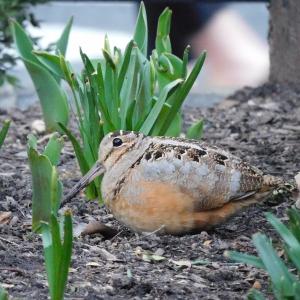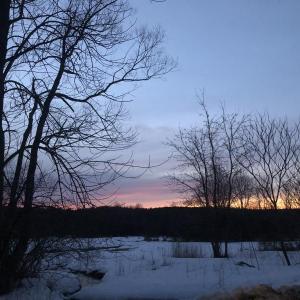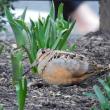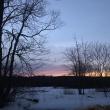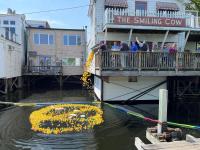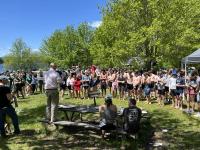Woodcock in the Snow
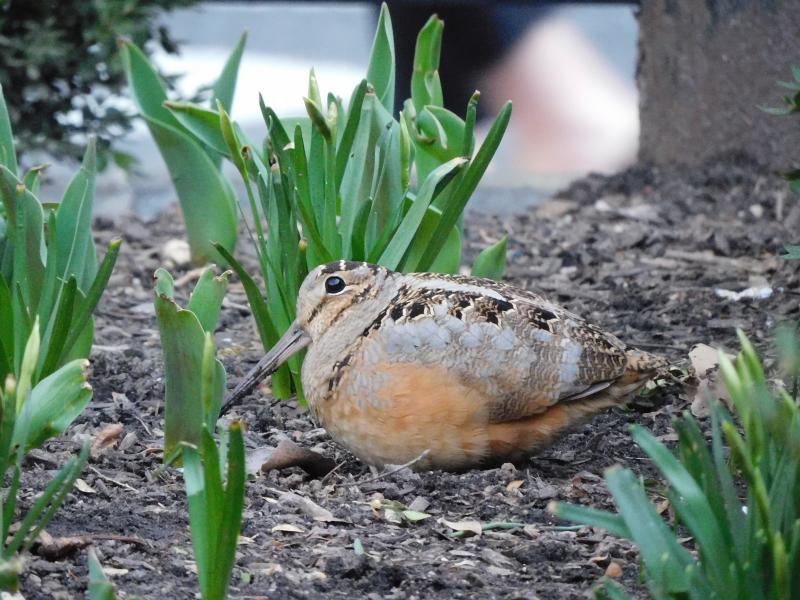 This lucky photographer got a great look at this American woodcock that stopped off in a New York City park during spring migration. More people hear the displaying males then see them as they are a shy and retiring bird. Photo by Rachel Casiano courtesy of Wikimedia Commons
This lucky photographer got a great look at this American woodcock that stopped off in a New York City park during spring migration. More people hear the displaying males then see them as they are a shy and retiring bird. Photo by Rachel Casiano courtesy of Wikimedia Commons
 The largely snow-covered field where the authors heard the displaying American Woodcock earlier this week. Courtesy of Jeff Wells
The largely snow-covered field where the authors heard the displaying American Woodcock earlier this week. Courtesy of Jeff Wells
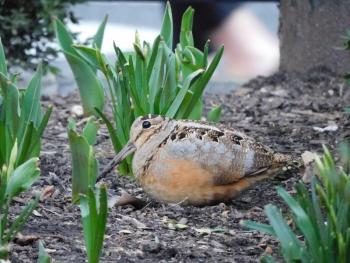 This lucky photographer got a great look at this American woodcock that stopped off in a New York City park during spring migration. More people hear the displaying males then see them as they are a shy and retiring bird. Photo by Rachel Casiano courtesy of Wikimedia Commons
This lucky photographer got a great look at this American woodcock that stopped off in a New York City park during spring migration. More people hear the displaying males then see them as they are a shy and retiring bird. Photo by Rachel Casiano courtesy of Wikimedia Commons
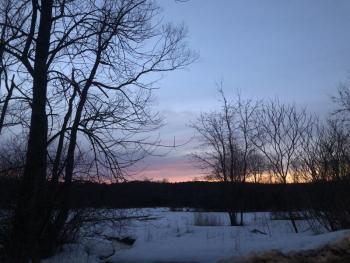 The largely snow-covered field where the authors heard the displaying American Woodcock earlier this week. Courtesy of Jeff Wells
The largely snow-covered field where the authors heard the displaying American Woodcock earlier this week. Courtesy of Jeff Wells
Last Friday, a friend told us that he had heard his first American woodcock of the year the night before. Woodcock are birds that are more often heard then seen, at least by most people. Those who seek them out to hunt in the fall with a good bird dog are an exception, although more often than not, even they just see them quickly flying away.
Woodcock are strange-looking birds. Squat, short-tailed with a long bill, big eyes, and a plump body, the American woodcock is pretty unique. A member of the sandpiper family, it stays hidden in the woods most of the time; the males do their elaborate breeding display under cover of almost-darkness. The best way to find an American woodcock is to listen along a brushy field edge, just as it’s getting dark, for the loud, low, nasal “peent” call that the males make as part of that breeding display. After “peenting” for a time, the male’s whistling wings can be heard as he ascends into the air. Soon, you may be able to hear a high-pitched twittering from high above in the sky. The twittering will get louder and louder as the male descends closer to the ground, and then it will abruptly stop. A few minutes, later the low “peent” will begin again, usually from the same or a nearby spot.
Occasionally, a woodcock will start the display when there is just enough light left in the sky that you can see the silhouette high above during the height of that twittering display flight.
But usually, it’s a completely aural experience for us humans.
Still, there is something thrilling about hearing that sound emanating out of a brushy alder thicket on a spring night. That’s why we went out this weekend, to one of our favorite spots to listen for woodcock ourselves.
Sure enough, despite the fact that the field was largely still covered in snow, a woodcock began loudly calling “peent, peent” from the alders along the edges where there was some open ground. We couldn’t see it, but he wasn’t very far away. Later we heard another about a mile away.
It was nice to know that they were back, at least some of them, but we wondered how well a bird that is known for eating earthworms could be faring with so much snow still on the ground. Of even more concern was the forecast of another winter storm hitting this week. Some recent research documented an increase in collisions of American woodcock with windows and buildings during spring snowstorms, apparently because the birds are low altitude night migrants. Snowy conditions cause them to fly even closer to the ground and obscure visibility for them, making them more vulnerable to collisions.
We hope that the woodcock here already will find nooks and crannies that allow them to weather the storm. And we hope that there are not large numbers of northward migrating woodcock that try to move through the storm.
One thing is for sure: We will be out in the evening on the roadside beside our favorite fields as soon as we can after the storm to listen hopefully for the “peent” of an American woodcock.
You should, too!
Jeffrey V. Wells, Ph.D., is a Fellow of the Cornell Lab of Ornithology and Vice President of Boreal Conservation for National Audubon. Dr. Wells is one of the nation's leading bird experts and conservation biologists. He is a coauthor of the seminal “Birds of Maine” book and author of the “Birder’s Conservation Handbook.” His grandfather, the late John Chase, was a columnist for the Boothbay Register for many years. Allison Childs Wells, formerly of the Cornell Lab of Ornithology, is a senior director at the Natural Resources Council of Maine, a nonprofit membership organization working statewide to protect the nature of Maine. Both are widely published natural history writers and are the authors of the popular books, “Maine’s Favorite Birds” (Tilbury House) and “Birds of Aruba, Bonaire, and Curaçao: A Site and Field Guide,” (Cornell University Press).

